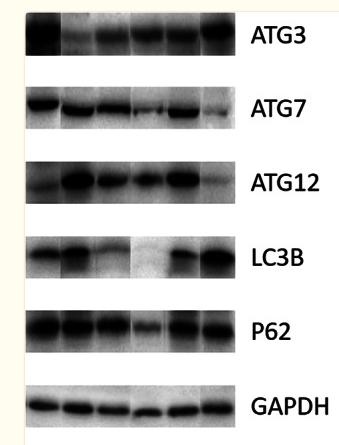ATG3 Antibody - #DF8216
| Product: | ATG3 Antibody |
| Catalog: | DF8216 |
| Description: | Rabbit polyclonal antibody to ATG3 |
| Application: | WB |
| Cited expt.: | WB |
| Reactivity: | Human |
| Prediction: | Pig, Bovine, Sheep, Rabbit, Dog, Chicken, Xenopus |
| Mol.Wt.: | 40 kDa; 36kD(Calculated). |
| Uniprot: | Q9NT62 |
| RRID: | AB_2841521 |
Product Info
*The optimal dilutions should be determined by the end user. For optimal experimental results, antibody reuse is not recommended.
*Tips:
WB: For western blot detection of denatured protein samples. IHC: For immunohistochemical detection of paraffin sections (IHC-p) or frozen sections (IHC-f) of tissue samples. IF/ICC: For immunofluorescence detection of cell samples. ELISA(peptide): For ELISA detection of antigenic peptide.
Cite Format: Affinity Biosciences Cat# DF8216, RRID:AB_2841521.
Fold/Unfold
2610016C12Rik; Apg 3; APG3; APG3 autophagy 3 like; APG3 like; APG3, S. cerevisiae, homolog of; APG3-like; APG3L; Apg3p; ATG 3; ATG3; ATG3 autophagy related 3 homolog; ATG3 autophagy related 3 homolog (S. cerevisiae); ATG3_HUMAN; Autophagy 3, S. cerevisiae, homolog of; Autophagy Apg3p/Aut1p like; autophagy related 3; Autophagy related protein 3; Autophagy-related protein 3; DKFZp564M1178; FLJ22125; hApg3; MGC15201; OTTHUMP00000214547; OTTHUMP00000214548; PC3 96; Protein PC3-96; Ubiquitin-like-conjugating enzyme ATG3;
Immunogens
A synthesized peptide derived from human ATG3, corresponding to a region within N-terminal amino acids.
Widely expressed, with a highest expression in heart, skeletal muscle, kidney, liver and placenta.
- Q9NT62 ATG3_HUMAN:
- Protein BLAST With
- NCBI/
- ExPASy/
- Uniprot
MQNVINTVKGKALEVAEYLTPVLKESKFKETGVITPEEFVAAGDHLVHHCPTWQWATGEELKVKAYLPTGKQFLVTKNVPCYKRCKQMEYSDELEAIIEEDDGDGGWVDTYHNTGITGITEAVKEITLENKDNIRLQDCSALCEEEEDEDEGEAADMEEYEESGLLETDEATLDTRKIVEACKAKTDAGGEDAILQTRTYDLYITYDKYYQTPRLWLFGYDEQRQPLTVEHMYEDISQDHVKKTVTIENHPHLPPPPMCSVHPCRHAEVMKKIIETVAEGGGELGVHMYLLIFLKFVQAVIPTIEYDYTRHFTM
Predictions
Score>80(red) has high confidence and is suggested to be used for WB detection. *The prediction model is mainly based on the alignment of immunogen sequences, the results are for reference only, not as the basis of quality assurance.
High(score>80) Medium(80>score>50) Low(score<50) No confidence
Research Backgrounds
E2 conjugating enzyme required for the cytoplasm to vacuole transport (Cvt), autophagy, and mitochondrial homeostasis. Responsible for the E2-like covalent binding of phosphatidylethanolamine to the C-terminal Gly of ATG8-like proteins (GABARAP, GABARAPL1, GABARAPL2 or MAP1LC3A). The ATG12-ATG5 conjugate plays a role of an E3 and promotes the transfer of ATG8-like proteins from ATG3 to phosphatidylethanolamine (PE). This step is required for the membrane association of ATG8-like proteins. The formation of the ATG8-phosphatidylethanolamine conjugates is essential for autophagy and for the cytoplasm to vacuole transport (Cvt). Preferred substrate is MAP1LC3A. Also acts as an autocatalytic E2-like enzyme, catalyzing the conjugation of ATG12 to itself, ATG12 conjugation to ATG3 playing a role in mitochondrial homeostasis but not in autophagy. ATG7 (E1-like enzyme) facilitates this reaction by forming an E1-E2 complex with ATG3. Promotes primary ciliogenesis by removing OFD1 from centriolar satellites via the autophagic pathway.
Conjugated to ATG12 at Lys-243. ATG12-conjugation plays a role in regulation of mitochondrial homeostasis and cell death, while it is not involved in PE-conjugation to ATG8-like proteins and autophagy.
Cleaved by CASP8 upon death ligand binding such as tumor necrosis factor-alpha. CASP8 cleavage blocks survival-related autophagy and favors apoptosis.
Cytoplasm.
Widely expressed, with a highest expression in heart, skeletal muscle, kidney, liver and placenta.
Belongs to the ATG3 family.
Research Fields
· Cellular Processes > Transport and catabolism > Autophagy - other. (View pathway)
· Cellular Processes > Transport and catabolism > Autophagy - animal. (View pathway)
References
Application: WB Species: Mouse Sample: cartilage tissues
Restrictive clause
Affinity Biosciences tests all products strictly. Citations are provided as a resource for additional applications that have not been validated by Affinity Biosciences. Please choose the appropriate format for each application and consult Materials and Methods sections for additional details about the use of any product in these publications.
For Research Use Only.
Not for use in diagnostic or therapeutic procedures. Not for resale. Not for distribution without written consent. Affinity Biosciences will not be held responsible for patent infringement or other violations that may occur with the use of our products. Affinity Biosciences, Affinity Biosciences Logo and all other trademarks are the property of Affinity Biosciences LTD.
